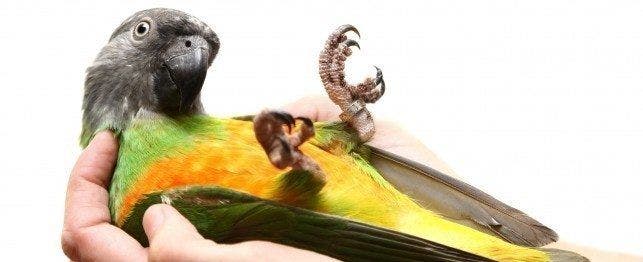
The Trick to Training Your Parrot
Parrots are highly intelligent animals that are easily motivated by praise and rewards, so if you keep training sessions short – 5 to 10 minutes once or twice daily – and positive, your feathered friend will be able to perform a repertoire of tricks before you know it.
Use positive reinforcement during training when the bird is learning a new trick. Your tone of voice should be soft and affirming and your words – “Good bird” or “Good job” – should be consistent so your bird will recognize them.
Treats should be small servings of something your bird really likes, such as a sunflower seed or one-half of a Cheerio. If the treat’s too big, it will take too long for the bird to eat it and your training session will be spent waiting for your bird to chew. Watch that your parrot doesn’t gain weight while he’s learning his new tricks. To counterbalance the rewards, you may have to remove some fat calories from his regular meals.
Clickers Are Good Training Tools
Clickers work well as training tools although they can be hard to find. When you first start training your bird, give a reward at the same time you say “Good bird” or click so he’ll begin to associate the sound with reward. Once he associates the praise (or click) with the treats, you can delay the treat.
If your bird knows the command “Step up,” teaching him to wave is easy. Hold your hand in front of your bird as though you want him to step. When he raises his foot up to come to you, say “Good bird” and give him a treat. Do this several times until he gets the idea. Once he starts to raise his foot for the treat on his own, wait to reward him until he has lifted his foot a little higher. Continue this step by step until your bird holds his foot beside his face and closes and opens his toes. Birds catch on very fast to the trick-for-a-reward routine.
Picking Up An Object
Choose a toy, key or other object that may interest your bird. When he touches the object, reward and praise him. After he seems to catch on to the fact that touching the object reaps a reward, make him pick it up. Continue until your bird picks up an object and brings it to you.
Other Tricks
Basically, anything that your bird does as a natural behavior can be turned into a trick. You can expand picking up an object into dunking a miniature basketball. If you get little roller skates, you can teach your bird to scoot across a table by breaking the task into small steps and building up to the big trick.
The best way to get a bird to talk is to use words that elicit a response. “Hello” is usually learned quickly because it’s a response. The door opens or the phone rings and your bird hears, “Hello.” It’s important to reward and respond verbally to words and sounds your bird makes. Never respond to screaming (unless it’s “the cat’s eating me!” scream). Also watch what you say in front of your bird. Sometimes they pick up the fastest on words you’d rather they didn’t repeat. Some people like to use recorded “teach your bird to talk” tapes and CDs. These work well for some birds, while others ignore them.
Hand Signals
If you want your bird to respond on his own, use very subtle hand signals. Just choose a signal and use it immediately, just as you use a verbal cue followed by reward and praise. Your bird will pick up easily on the slightest finger movement.
In Conclusion
- Keep your lessons short so they remain a positive experience for both you and your bird.
- Cue and reward your bird quickly and consistently.
- Teach complicated tricks in small steps.
- Take advantage of your bird’s natural behaviors. Cue and reward them until he does it on command.
- Finally, BE PATIENT. Sometimes you have to take two steps back to make one step forward.